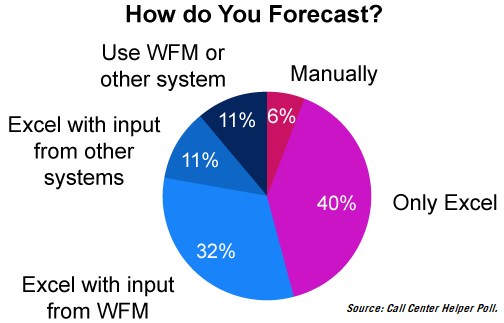May 5, 2020 by Siobhan Climer , John Irey, and Kleid Gjataj
The continuing evolution of workforce management (WFM) is directly linked to changes in the broader technology sphere. The 2020 Pelorus Associates WFM Report uncovers several underlying trends impacting adoption of WFM technology.
The main 2020 WFM trends identified in the report are:
- Geographic Region Factors
- WFM Use Case Expansion
- Cloud Migration
- AI Utilization
- Improved Analytics and Reporting
- Recruitment and Retenion
Let’s break down each WFM trend and understand if – and when – workforce management becomes an integral part of the contact center technology stack.

What Is WFM?
First, a quick review: workforce management is a term that covers the topic of managing the variety of staffing needs in call and contact centers. Contact centers use technology and processes to manage their workforce, so they can:
- Forecast contact volumes
- Schedule staff around forecasts
- Intraday management for unexpected rises or absenteeism
- Create a business continuity plan
A recent Call Centre Helper poll found that the majority (40%) of call and contact centers manage their WFM data with Excel spreadsheets exclusively. However, this data was gathered from a webinar designed for those looking to build better spreadsheets, so maintain some healthy skepticism.

The Value Of WFM Technology
Manually forecasting and implementing data-driven decisions from these spreadsheets is challenging, to say the least. In addition, erroneous data and trends often lead to significant missteps in managing resources.
Increasingly, contact centers are using WFM technology to improve forecast accuracy, simplify WFM decision-making, effect improved communications across teams, and increase ROI.
Learn how to start planning for WFM technology or other contact center technology needs with our eBook: Customers Drive, You Navigate: Your Contact Center Roadmap to Customer Care Success.
The 2020 WFM Trends Worth Noting
The trends noted in the 2020 WFM Trends Report are comprehensive and detailed, offering an aggregate of many themes Mindsight sees in the industry.
Geographic Regions Factor Into WFM Adoption
The primary WFH vendors have changed little over the last two years and include Cisco, Verint Systems, Aspect Software, NICE-IEX, Calabrio, and Genesys. However, WFM adoption does vary significantly by region.
WFM adoption is highest in North America, dropping far lower in Europe, the Middle East, and Africa. In other regions, identified as “outsourcer-heavy”, the investment in WFM per agent drops even further.

Increased WFM Use Cases
A big 2020 WFM trend is the increase of overall WFM applications, primarily seen in two categories. First, WFM is no longer only used to manage call center agents. Many companies are adopting WFM to also manage back-office employees, who frequently outnumber actual agents.
Second, WFM technology is no longer only used by enterprise-level call centers. The ROI of WFM technology is such that even small and medium-sized contact centers see significant returns after investment.

Cloud Adoption Eases WFM Implementation
Back in 2012, less than 4% of WFM revenue sourced from cloud models. Today, that number is estimated to be close to 70%. The dramatic shift towards cloud deployments means WFM is more accessible and adds more value than ever before.
How different vendors approach cloud computing – and focus on specific cloud providers (AWS or MS Azure) – will likely impact the market dramatically in the coming years.

A.I. Creates Greater Efficiency for WFM
Machine learning (ML) and artificial intelligence (AI) have long been touted as approaching disruptors in the technology sector. For contact centers, the use of ML and AI is more visible today than in almost any other industry.
WFM integrates AI technology to improve forecasts, synthesize incredible amounts of data, and “learn” new models to customize individual WFM needs. These can lead to incredible savings for the contact center.

Value of Analytics and Reporting Increases
While many call centers are still using Excel spreadsheets for their analytics and reporting, SaaS deployments of WFM have upped the ante in overall WFM forecasting capabilities. Contact centers that do not employ WFM technology are unable to effectively leverage resources and grow.

WFM Technology Does More
As WFM has matured, it has taken on new capabilities. Not only does it provide forecasting, but WFM technology now integrates gamification, professional development, coaching and training support, performance metrics, knowledge management, and tools to help with long-term planning and overall contact center growth.

Retention and Recruitment Tied to WFM
The world is always changing, and new call center employees (and veteran agents) respond positively to contact center environments utilizing WFM technology. Agents report a correlation between the implementation of WFM and overall feelings of stress, over-work, and management support.
In addition, WFM technology is fundamental to the successful deployment of remote call center agents. The vendors are responding to new desires and needs in the workforce and integrating them directly into the technology.
How 2020 WFM Trends Impact The Contact Center – Today and Beyond
If you haven’t already adopted a WFM solution, it’s probably time. As more call and contact centers use technology to increase overall workplace efficiencies, those who do not will fall farther and farther behind.
To find out more about WFM technology solutions available with Cisco or Genesys, or to talk more about your specific call center needs, call and speak with Mindsight’s principal contact center consultants, John Irey and Kleid Gjataj.
Like what you read?
Contact us today to discuss the 2020 WFM trends.
About Mindsight
Mindsight is industry recognized for delivering secure IT solutions and thought leadership that address your infrastructure and communications needs. Our engineers are expert level only – and they’re known as the most respected and valued engineering team based in Chicago, serving emerging to enterprise organizations around the globe. That’s why clients trust Mindsight as an extension of their IT team.
Visit us at http://www.gomindsight.com.
About The Authors
John Irey is a Principal Consultant at Mindsight focused on Cisco platforms. With nearly 20 years of experience in information technology, John has helped businesses of every size optimize the technology powering the contact center. He seeks to provide a consultative voice to contact center leaders and continues to focus on emerging technology, such as machine learning and artificial intelligence.
Kleid Gjataj is a Principal Consultant at Mindsight focused on Genesys platforms. With nearly 15 years of experience in both domestic and international consulting, Kleid helps contact centers of all sizes bridge the gap between business and technology. His extensive experience with IVR, ACD, screen pops, omnichannel, speech analytics, quality management, outbound dialer, and custom applications is grounded in understanding the critical value of the customer journey.
Siobhan Climer writes about technology trends in education, healthcare, and business. With over a decade of experience communicating complex concepts around everything from cybersecurity to neuroscience, Siobhan is an expert at breaking down technical and scientific principles so that everyone takes away valuable insights. When she’s not writing tech, she’s reading and writing fantasy, hiking, and exploring the world with her twin daughters. Find her on twitter @techtalksio.
Which To Choose? Cisco UCCE vs PCCE: A Contact Center Report



